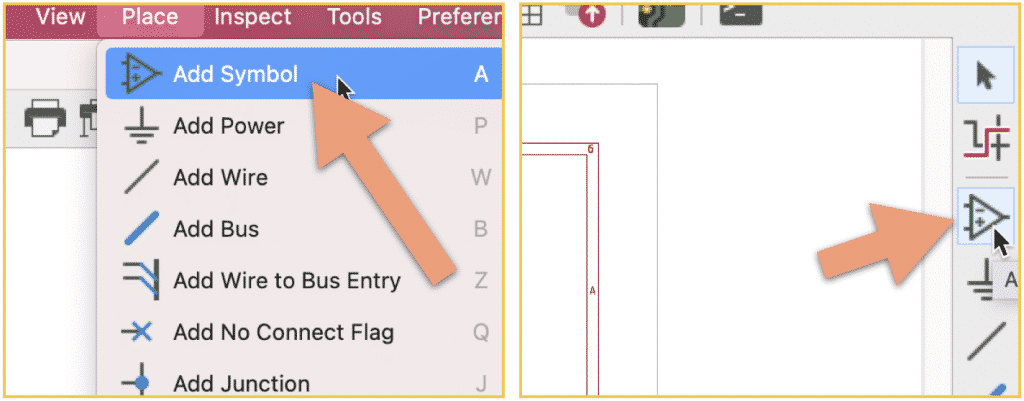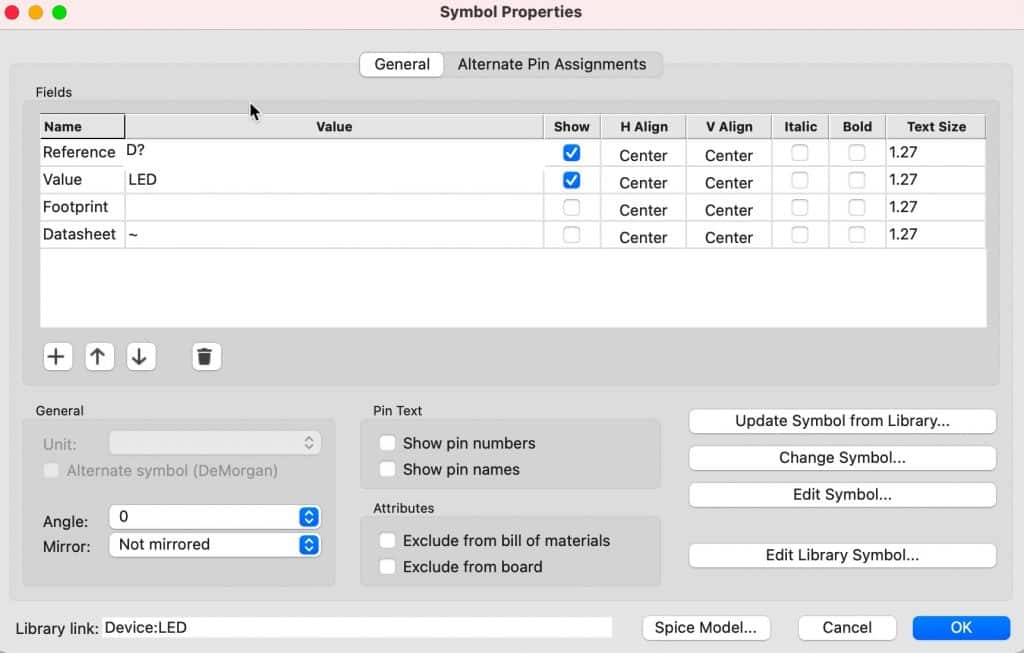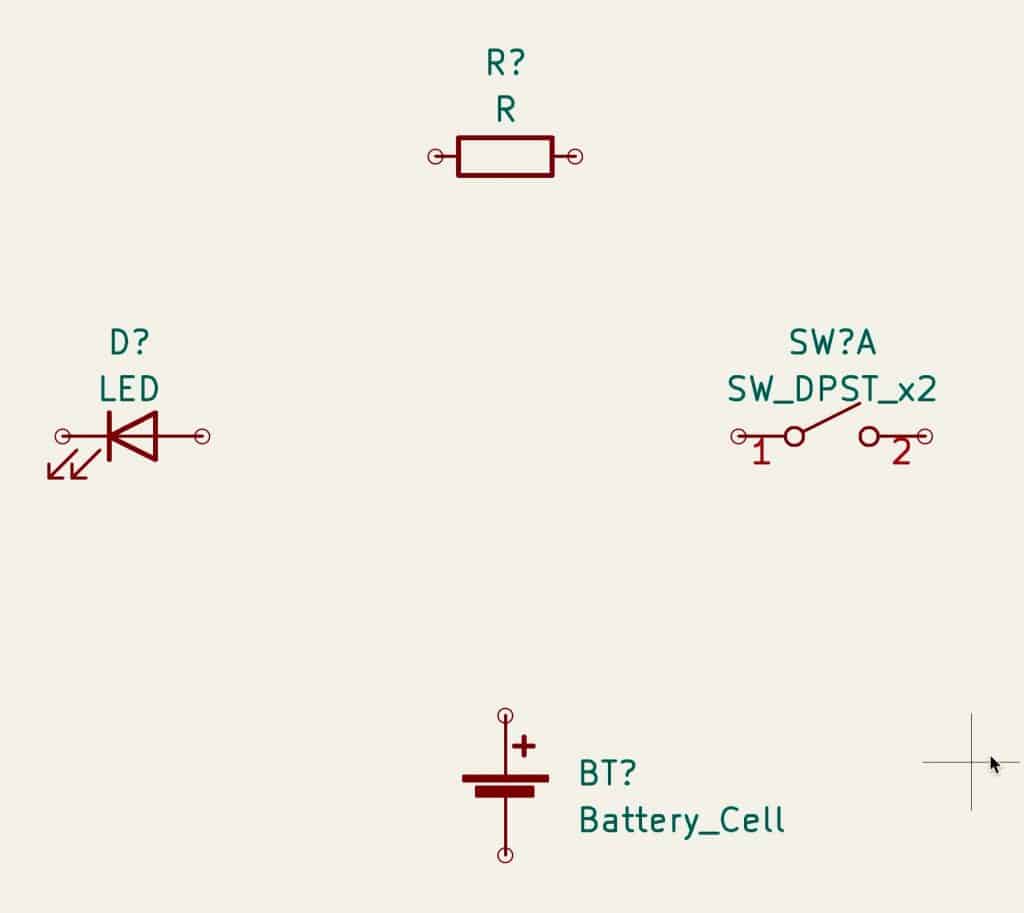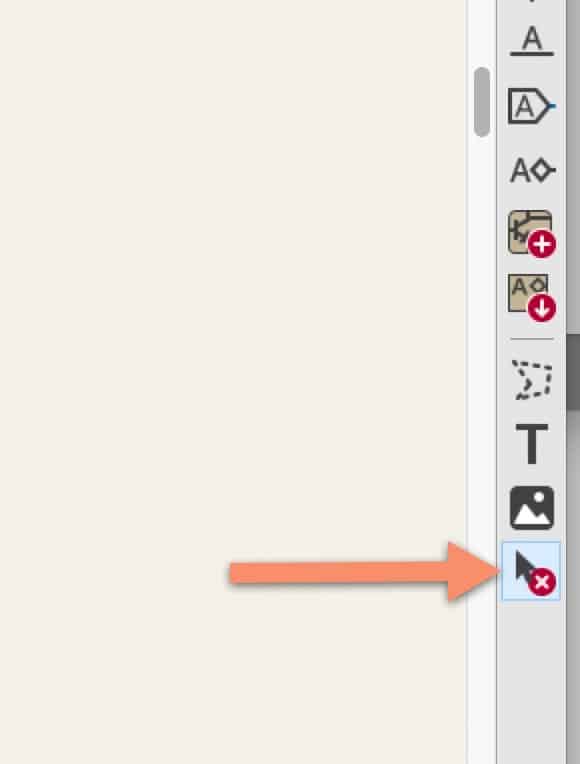KiCad Like a Pro 3e – eBook
-
eBook status1 Lecture
-
00 - Front matter5 Lectures
-
01 - Getting started with PCB design6 Lectures
-
02 – Getting started with KiCad12 Lectures
-
Introduction
-
KiCad Project Manager (main window)
-
Overview of the individual KiCad apps
-
Paths and Libraries
-
(Legacy) KiCad Project Manager (main window)
-
(Legacy) Overview of the individual KiCad apps
-
(Legacy) Paths and Libraries
-
Create a new project from scratch
-
Create a new project from a template
-
KiCad on Mac OS, Linux, Windows
-
(Legacy) Kicad 6 on Mac OS, Linux, Windows
-
(Legacy) Major Differences between KiCad 6.0 and 5.0
-
Introduction
-
03 - Project: A hands-on tour of KiCad - Schematic Design11 Lectures
-
Introduction to schematic design
-
Quick intro to the design workflows
-
The finished KiCad project and directory
-
Start Kicad and create a new project
-
1 - Start Eeschema, setup Sheet
-
2 - Add symbols
-
3 - Arrange, annotate, associate
-
4 - Wiring
-
5 - Nets
-
6 - The Electrical Rules Check
-
7 - Comments with text and graphics
-
Introduction to schematic design
-
04 - Project: A hands-on tour of KiCad - Layout10 Lectures
-
Introduction to layout design and objective of this section
-
1 - Start Pcbnew, import footprints
-
2 - Outline and constraints (edge cut)
-
3 - Move footprints in place
-
4 - Route (add tracks)
-
5 - Refine the outline
-
6 - Silkscreen (text and graphics)
-
7 - Design rules check
-
8 - Export Gerbers and order
-
The manufactured PCB
-
Introduction to layout design and objective of this section
-
05 - Design principles and PCB terms16 Lectures
-
06 - PCB design workflows17 Lectures
-
The KiCad Schematic Design Workflow
-
Schematic Design Step 1: Setup
-
Schematic Design Step 2: Symbols
-
Schematic Design Step 3: AAA (Arrange, Annotate, Associate)
-
Schematic Design Step 4: Wire
-
Schematic Design Step 5: Nets
-
Schematic Design Step 6: Electrical Rules Check
-
Schematic Design Step 7: Comments and Graphics
-
The KiCad Layout Design Workflow
-
Layout Design Step 1: Setup
-
Layout Design Step 2: Outline and constraints
-
Layout Design Step 3: Place footprints
-
Layout Design Step 4a: Route
-
Layout Design Step 4b: Copper fills
-
Layout Design Step 5: Silkscreen
-
Layout Design Step 6: Design rules check
-
Layout Design Step 7: Export & Manufacture
-
The KiCad Schematic Design Workflow
-
07 - Fundamental Kicad how-to: Symbols and Eeschema17 Lectures
-
About this section
-
Left toolbar overview
-
Top toolbar overview
-
Right toolbar overview
-
Schematic editor preferences
-
How to find a symbol with the Chooser
-
How to find schematic symbols on the Internet
-
How to install symbol libraries in bulk
-
How to create a custom symbol
-
How to associate a symbol with a footprint
-
Net labels
-
Net classes
-
Hierarchical sheets
-
Global labels
-
Hierarchical labels and import sheet pin
-
Electrical rules and customization
-
Bulk editing of schematic elements
-
About this section
-
08 - Fundamental Kicad how-to: Footprints and Pcbnew31 Lectures
-
Introduction
-
Left toolbar overview
-
Top toolbar overview
-
Top toolbar Row 1
-
Top toolbar Row 2
-
Right toolbar overview
-
Right toolbar main buttons
-
Right toolbar overview - Appearance
-
Layout editor preferences (Preferences window, PCB Editor)
-
Board Setup
-
Board Setup - Board Stackup
-
Board Setup - Text & Graphics
-
Board Setup - Design Rules and net classes
-
Board Setup - Design Rules - Custom Rules and violation severity
-
How to find and use a footprint
-
Footprint sources on the Internet
-
How to install footprint libraries
-
Filled zones
-
Keep-out zones
-
Interactive router
-
Length measuring tools
-
Bulk editing
-
Create a custom footprint, introduction
-
Create a new library and footprint
-
Create a custom footprint, 1, Fabrication layer
-
Create a custom footprint, 2, Pads
-
Create a custom footprint, 3, Courtyard layer
-
Create a custom footprint, 4, Silkscreen layer
-
Use the new footprint
-
Finding and using a 3D shape for a footprint
-
How to export and test Gerber files
-
Introduction
-
09 - Project: Design a simple breadboard power supply PCB23 Lectures
-
Introduction
-
Schematic design editing
-
Schema 1 - Setup
-
Schema 2 - Symbols
-
Edit Component values
-
Schema 3 - Arrange, Annotate
-
Schema 3 - Associate
-
Schema 4 - Wiring
-
Schema 5 & 6 - Nets and Electrical Rules Check
-
Schema 7 - Comments
-
Introduction to layout editing
-
Layout 1 - Setup
-
Layout 2 - Outline and constraints
-
Layout 3 - Place footprints
-
Layout 2 supplemental - Refine outline
-
Layout 4 - Routing
-
Layout 5 - Copper fills
-
Layout 6 - Silkscreen
-
Layout 7 - Design Rules Check
-
Layout 8 - Export and Manufacture
-
Finding and correcting a design defect
-
Fix the schematic
-
Fix the layout
-
Introduction
-
10 - Project: A 4 x 8 x 8 LED matrix array clock25 Lectures
-
Project - Introduction
-
Schematic design
-
Schema 1 - Setup
-
Schema 2 - Symbols
-
Schema 3 - Arrange, Annotate
-
Schema 3 - Associate
-
Schema 4 - Wiring
-
Schema 5 - Nets
-
Schema 6 - Electrical Rules Check
-
Schema 7 - Comments
-
Schema - Last-minute edits
-
Layout design
-
Layout 1 - Setup
-
Layout 2 - Outline and constraints
-
Layout 3 - Place components
-
Layout 2 - Refine outline
-
Layout 3 - Move footprints to back layer
-
Layout 4 - Route
-
Layout 4 - Copper fills
-
Layout 5 - Silkscreen
-
Layout 6 - Design Rules Check
-
Layout 7 - Manufacture
-
Bonus - 3D shapes
-
Bonus - Found a bug in the schematic! (and fix)
-
The assembled and working PCB
-
Project - Introduction
-
11 - Project: MCU datalogger with build-in 512K EEPROM and clock37 Lectures
-
Project - Introduction
-
Create the new project and create new Git repository
-
Schematic design
-
Schema 1 - Setup
-
Schema 2 - Symbols
-
Schema 2 - Sheet 2
-
Schema 3 - Arrange, Annotate
-
Edit Component values
-
Schema 3 - Associate
-
Schema 4 - Wiring of sheet 1
-
Schema 4 - Wiring of sheet 2
-
Schema 5 - Nets
-
Schema 6 - Electrical Rules Check
-
Schema 7 - Comments
-
Git, setup in a 2-layer PCB branch
-
Layout design
-
Layout 1 - Setup
-
Layout 2 - Outline and constraints
-
Layout 3 - Place components
-
Layout 2 - Outline refinement
-
Layout 4 - Route
-
Layout 4 - Copper fills
-
Layout 4 - Routing improvements
-
Layout 5 - Silkscreen
-
Layout 4 - Routing violations and complete silkscreen
-
Layout 6 - Design Rules Check
-
Layout 7 - Manufacture
-
3D shapes
-
Merge 2-layer branch to main
-
Design 4 Layer PCB in new Git branch
-
Four-layer PCB routing
-
Four-layer PCB manufacturing
-
Updating layout from changes to the schematic with Git
-
Finding and correcting a design defect
-
Fix the schematic
-
Fix the 2 layer PCB layout
-
Fix the 4 layer PCB layout
-
Project - Introduction
-
12 - Project: An ESP32 clone25 Lectures
-
Project - Introduction
-
Schema 1 - New KiCad project and Schematic Setup
-
Schema 2 - Symbols
-
Schema 3 - Annotate and set component values
-
Schema 3 - Arrange
-
Schema 3 - Associate
-
Schema 4 - Wiring
-
Schema 5 - Nets and Net Classes
-
Schema 6 - Electrical Rules Check
-
Schema 7 - Comments
-
Layout - Introduction
-
Layout 1 - Setup
-
Layout 2 - Outline and constraints
-
Layout 3 - Place components
-
Layout 2 supplemental - refine outline
-
Layout 4 - Route
-
Layout 4 - Copper fills and keep out areas
-
Layout 5 - Silkscreen
-
Layout 4 - Routing improvements
-
Layout 6 - Design Rules Check
-
Layout 7 - Manufacture
-
3D shapes
-
Finding and correcting a design defect
-
Fix the schematic
-
Fix the layout
-
Project - Introduction
-
13 - Recipes56 Lectures
-
How to create a custom graphic
-
Change a symbol in bulk
-
Change a footprint in bulk
-
Interactive delete
-
Find and Replace (Eeschema)
-
Edit Text & Graphics Properties
-
Edit Track & Via Properties (Pcbnew)
-
Text variables
-
Board Setup - pre-defined sizes for tracks and vias
-
Board Setup - Design rules violation severity
-
Board Setup - Custom design rules
-
Schematic Setup - Electrical Rules and violation severity
-
Schematic Setup - Electrical Rules and Pin conflicts map
-
Field name templates
-
Bill of Materials method 1: Pcbnew
-
Bill of Materials method 2: Eeschema
-
Bill of Materials method 3: Interactive HTML BOM plugin
-
Import components from Snapeda
-
The Freerouting autorouter introduction
-
Install and start FreeRouting on MacOS
-
Install and start FreeRouting on Linux Kubuntu
-
Install and start FreeRouting on Windows
-
How to use the Freerouting autorouter 2-layer example
-
How to use the Freerouting autorouter 4-layer example
-
Pcbnew Inspection menu
-
Single-track and differential pair routing
-
Track length tuning
-
Differential pair skew tuning
-
Interactive router modes
-
The footprint wizard
-
Pin and wire highlighter tool
-
Pcbnew Origins
-
How to create custom sizes for tracks and vias
-
KiCad project management with Git
-
Install Git
-
Git configuration
-
Create a new KiCad project Git repository
-
How to ignore files with Gitignore
-
Basic Git commands: add, commit, log, diff
-
Basic Git commands: branch
-
Basic Git commands: merge
-
Sharing your KiCad project on GitHub
-
How to customize the editor color scheme
-
How to import an EAGLE, Altium, or Cadstar project
-
The circuit simulator
-
Prepare the circuit for simulation
-
Configure the simulator
-
Simulate
-
Import a KiCad 5 project
-
KiCad project templates
-
Use a system project template
-
Create a user project template
-
Archive/un-archive and share a project
-
How to use buses
-
Calculate the width of a trace
-
Design a custom schematic sheet
-
How to create a custom graphic
-
14 - What's new in KiCad 714 Lectures
-
Introduction
-
14.2. Text and text boxes
-
14.3. Plugin and Content Manager: Plugins
-
14.4. Plugin and Content Manager: Libraries
-
14.5. Plugin and Content Manager: Themes
-
14.6. Drag and drop
-
14.7. Command Line Interface
-
14.8. Orthogonal dragging
-
14.9. PDF export improvements
-
14.10. PCB editor - Unroute selected route
-
14.11. PCB editor - Automatically complete trace route
-
14.12. Search panel
-
14.13. Improved Pack & Move footprints
-
14.14. More information and documentation about KiCad 7
-
Introduction
-
XX – Content by contributing authors4 Lectures
2 – Add symbols
Did you find an error in this page? Please report it. eBook version 12.
In this chapter, you will complete step one of the schematic design workflow that you learned about in the second chapter of this part of the book.
This chapter will show you how to find symbols using the symbol chooser and place them in the schematic design editor. To keep this first project simple, I will be using symbols that exist in KiCad’s libraries.
To drop a symbol to the editor sheet, you need to first bring up the symbol chooser window. The symbol chooser contains a listing of all available symbol libraries and their contents, as well as a search engine. You can look for a symbol by searching for it (if you know its name), or browsing for it. To bring up the symbol chooser, use the “A” hotkey, or choose the “Add Symbol” option under the “Place” top menu, or click the symbol button in the right toolbar (Figure 3.6.1).

The symbol chooser window will appear (Figure 3.6.2).

You can look for a symbol by typing a few letters of its name in the search box (1) or navigate the library and symbol list (2). In the example above, I am looking for the LED symbol, so I have typed “led” in the search box. The symbol chooser narrows down the contents of the listing pane (2) to symbols that contain “LED” in their name. I have clicked on the item in the first row. This prompts the symbol to appear in the symbol preview pane (3). Information about the selected symbol appears in the bottom left corner pane of the window. Some symbols also have associations with one or more footprints. You can choose one of the footprints by using the drop-down menu (4) and verifying that you have the correct association in the footprint preview pane (5). In my example, I don’t want to set an association at this time, so I leave the footprint dropdown unchanged and click OK (you may also double click on the device row (2) to select the symbol and dismiss the window).
After you dismiss the symbol chooser window, the symbol will be tied to the mouse cursor. You will be able to move the symbol around the editor. Find a good location for it, and then left-click to place it (Figure 3.6.3).

While a symbol is selected (you will see a bluish halo around it), you can use the “R” (counter-clockwise rotation) hotkey to change its orientation. You can select an unselected symbol by left-clicking on it. Remember that to un-select a selected symbol, simply left-click on any blank area. Also, to move a selected symbol, with the cursor over the selected symbol, press and hold the left mouse button and drag the symbol.
You can double-click on the symbol to bring up its properties window (Figure 3.6.4):

We will be editing the properties of this symbol later to do things such as assign a footprint or add a URL to a data sheet. For now, take a moment to become familiar with it, and click “OK” to dismiss it.
Repeat the process I described above to add the remaining symbols:
- Resistor (search for “R”).
- Switch (search for “SW_DPST_x2”).
- Battery (search for “Battery_Cell”).
Remember that you are working with symbols and that each symbol can be associated with a variety of “real life” footprints. For example, the battery symbol can be associated with footprints that belong to a 3.3V coin battery cell or a AA alkaline battery holder. We’ll do the associations later.
Once you have completed the addition of the four symbols, your schematic diagram will look like this (Figure 3.6.5):

If you have made a mistake, it is easy to fix. Say that you changed your mind and want to replace a symbol with another. The easiest way is to delete the incorrect symbol by selecting it and hitting the “delete” key. Then use the symbol chooser to find the replacement symbol. You can also use the interactive delete tool from the right toolbar. Once you enable this tool, you can delete any item in the editor by clicking on it (Figure 3.6.6).

You can also change symbols in bulk. To learn more about this, please read the dedicated chapter on this topic.
The schematic editor now contains the four symbols I need for my simple circuit. I have not done the final placement and the wiring yet, as I’ll do that in the next two steps of the workflow.
For now, save the document, and continue with the next chapter.
